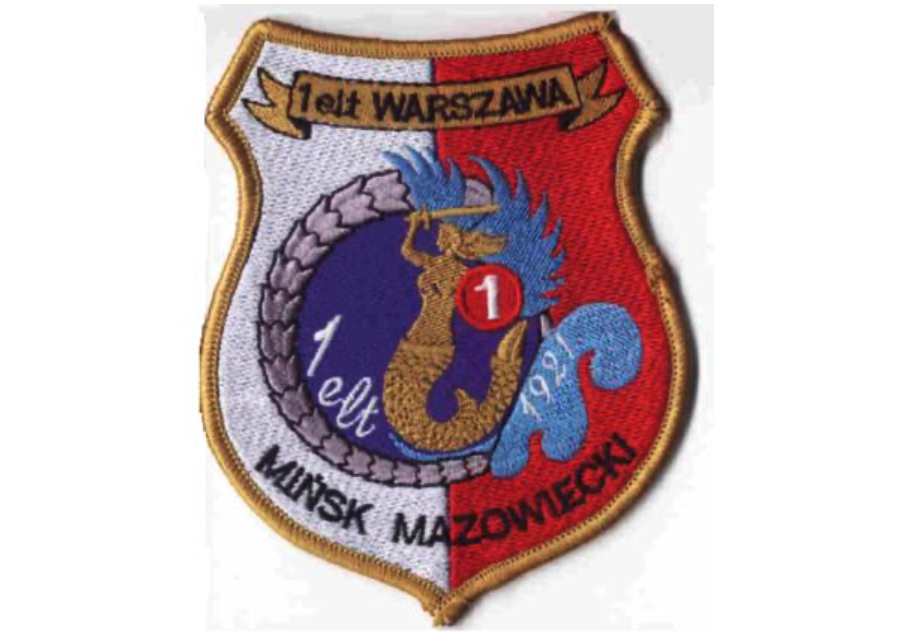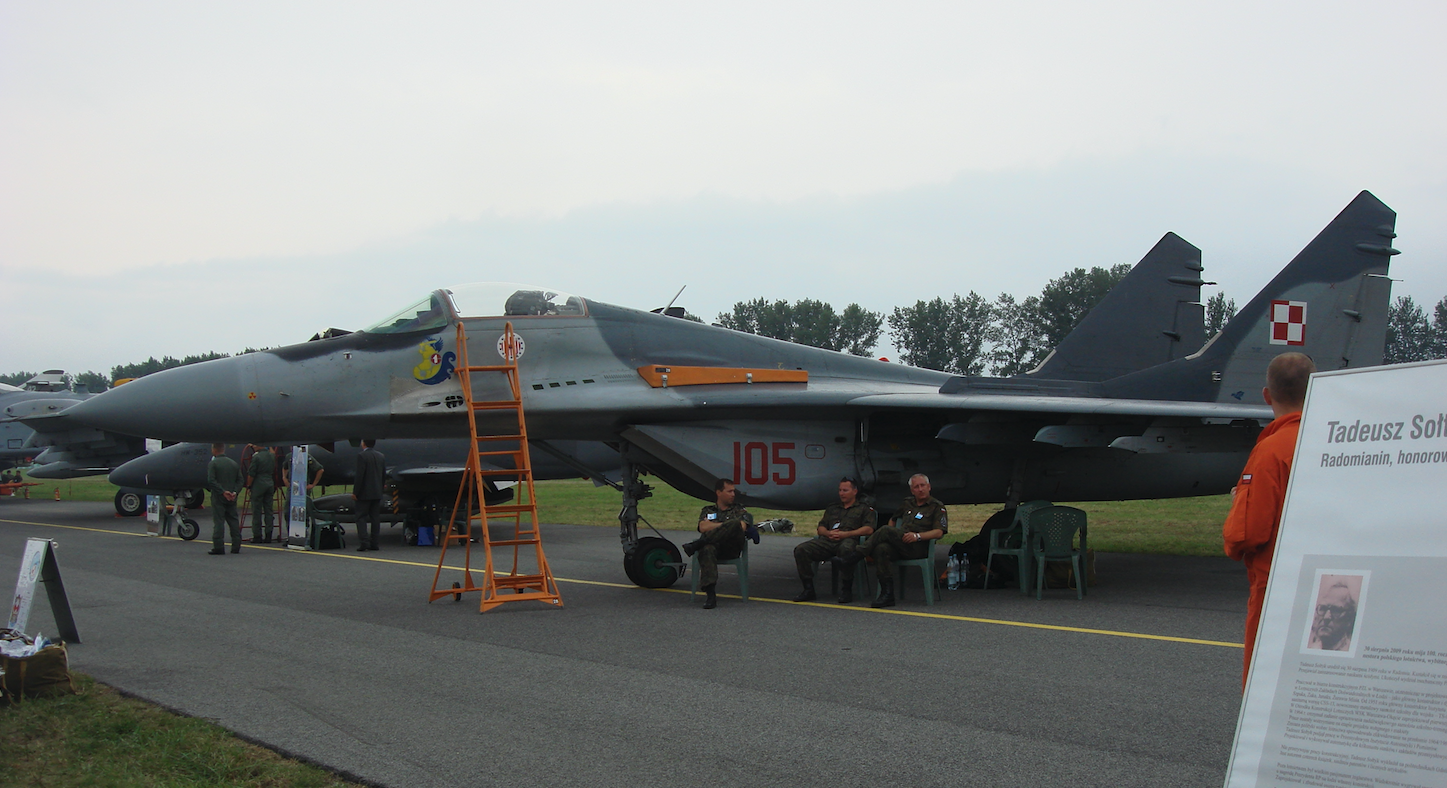Mińsk Mazowiecki 2010-01-22
1st Tactical Aviation Squadron "Warszawa" in Mińsk Mazowiecki.
January 1, 2000 – July 1, 2010
History
See 1st Fighter Aviation Regiment "Warszawa".

On January 1, 2001, as a result of the restructuring of the Air Force and Air Defense, two military units were established in place of the 1st Fighter Aviation Regiment (1. PLM): First - 23rd Air Base - a logistics unit that took over the economic property of the 1st Regiment . The second - 1st Tactical Aviation Squadron - a line unit that took over the planes and traditions of the 1st Regiment.
This was done on the basis of the Order of the Commander of the Air Force and Air Defense No. Pf - 153 of November 28, 2000. These transformations concerned all air regiments, except for the 36th Special Transport Aviation Regiment, which had its own transport specificity. The 23rd Air Base took over its command of fixed assets and everything related to maintaining the airport in full readiness and efficiency. The 1st ELT, as a combat unit, had planes and flying personnel.
The new Squadron took over the traditions; 1. PLM Warsaw. 7th Fighter Squadron named after Tadeusz Kościuszko 1918-1921 19th Fighter Squadron 1919-1929 111th Fighter Squadron, 1st Aviation Regiment 1921-1929 113th Fighter Squadron, 1st Aviation Regiment 1933-1939 1/145 Warsaw Fighter Squadron 1940 303rd Tadeusz Kościuszko Squadron 1940-1947 316th Warsaw Squadron 1941-1947.
Subsequent transformations in the Polish Air Force resulted in the 1st ELT and 23rd Blot being subordinated to the 1st Tactical Aviation Brigade with headquarters in Świdwin, which then underwent a cosmetic name change to the 1st Tactical Aviation Wing.
Further changes are visible after the Krzesiny Base and the 3rd ELT came under one command. Similar changes were to be expected in Mińsk Mazowiecki.
The equipment of the 1st ELT included aircraft inherited from the 1st PLM: Mikojan-Guriewicz MiG-29 9/12 / UB fighters. Training and training PZL TS-11 Iskra. PZL Mi-2 helicopters (taken over by the 2nd Transport and Liaison Aviation Squadron, and from 2009, by the 2nd Search and Rescue Group in Mińsk Mazowiecki). Transport PZL An-2 (taken over by the 2nd Transport and Liaison Aviation Squadron, and in 2008, decommissioned).

After the formation of the 1st ELT, 12 MiG-29 aircraft and 18 pilots were reported to the NATO Immediate Reaction Force.
In 2002, the 1st Tactical Aviation Squadron "Warszawa" was named after Brigadier General pilot Stefan Pawlikowski.
By decision of the Minister of National Defense No. 33/MON of February 14, 2003, the Squadron Day was set on May 19. To commemorate the beginning of the formation of the 1st PLM Warsaw in 1943, in Grigoriewskoye at CCCP.
Exercises 1 ELT.
It is difficult to list all the exercises in which the 1st ELT has participated over the last 10 years, constantly improving its readiness to defend the borders of the Republic of Poland, but also to perform new tasks resulting from the new geopolitical situation.
In 2001, the following maneuvers, exercises and meetings took place; Chopin 2001 in France in Dijon (April 2001), ODAX 2001 (with the participation of over 100 combat aircraft from France, Spain, Germany, USA, UK, Morocco and Singapore), NATO Air Meet 2001 in Norway at the Roland base (September 2001 ), Clean Hunter 2001, Sentry White Eagle 2001 (May 2001), Polish-American exercise in Mińsk Mazowiecki with the participation of F-15A/B aircraft from the 173rd Wing of the Oregon National Guard).
In 2002; Strong Resolve 2002 (NATO exercise in Greater Poland, February-March 2002), Lone Kestrel 2002.
In 2003; Clean Hunter 2003 (Polish MiG-29 and Su-22, taking off from Świdwin Airport, took part in NATO exercises over Eastern Germany and south-eastern Denmark, June-July 2003), NATO Air Meet (NAM) 2003 in France, NATO Air Meet 2003 for the first time in Poland (September 8-18, 2003, Krzesiny Airport). Also in 2003, the Squadron took part in the protection of the "Air Force One" plane with the US President on board.
In 2004; Ustka 2004, Clean Hunter 2004, Exercise testing the "Renegade" procedure (procedures implemented after the tragedy on September 11, 2001, in the USA), Polish Dancer 2004 (Poland-UK exercises, Sea Harrier FRS.2 aircraft from the 801st Naval Squadron RAF based at the Mińsk Mazowiecki Airport, they trained with MiG-29 and Su-22 from the 40th ELT. March 2004).
In 2005; Sentry White Falcon 2005, British exercise with CQWI troops in Leuchards, Scotland. NEWTP 2005 (exercise for the defense of the Polish system, which is part of the NATO system. May 2005).
In 2006; Polish-British exercise Lone Eider 2006 (Malbork Airport). Also in 2006, the 1st ELT provided cover for the visit of Pope Benedict XVI to Poland.
In 2007; including the cyclical Fruit Fly exercise with the AWACS Fruit Fly air command and guidance system.
It is impossible to forget about the annual meetings of the management staff of air squadrons, which are probably traditionally held at Krzesiny Airport. These rallies are combined with tasks performed in the area of the 21st Central Aviation Training Ground in Nadarzyce.
The airport in Janów near Mińsk Mazowiecki is still the site of many foreign visits at various levels, which began in the 1990s. An integral element of these visits were higher pilotage demonstrations on the MiG-29, performed by pilot Major H. Chołuj and pilot Major J. Wojtaszczyk.
The pilots of the 1st ELT mainly used the Jagodne training ground.
In the period from March to May 2003, the planes of the 1st ELT operated from Malbork Airport because the Runway (RWY) in Mińsk Mazowiecki was being renovated.
Air Policing. Orlik Mission. 2006.
In accordance with the signed agreement, the NATO pact undertook the air defense of the three Baltic countries; Lithuania, Latvia and Estonia, which are unable to maintain fighter aviation on their own, and joined NATO on March 29, 2004. The mission has been carried out on a rotational basis since 2004-04-02 by the air forces of individual NATO countries. When will the mission end? Currently (2020) it is difficult to answer this question. Other security and defense systems in this region of Europe have not yet been developed. In the last days of January 2010, the press reported that Germany had been blocking the creation of an effective defense system for these countries within NATO for many years. In 2014, Russia tightened its aggressive policy. The culmination was the shooting down of a Malaysian passenger plane.
From January 1, 2006 to March 31, 2006, the Republic of Poland took over responsibility for the air protection of the Baltic States, as part of its alliance obligations.
The legal basis for participation in the Air Policing mission - apart from allied obligations - is the decision of the President of the Republic of Poland of November 25, 2005, on the use of the Polish Military Contingent as part of the Allied Forces of the North Atlantic Treaty Organization, in the military surveillance of the airspace of the Republic of Estonia, the Republic of Lithuania and the Republic of Latvia. , which entered into force on November 29, 2005.
The first Polish unit to be assigned to this difficult but honorable task was the 1st ELT Warszawa from Mińsk Mazowiecki. On Tuesday, December 27, 2005, at 09:00 at the Mińsk Mazowiecki Airport, a farewell ceremony was held for the Polish Military Contingent (PKW) "Orlik", going to Lithuania as part of the NATO "Air Policing" mission. The ceremony was attended by representatives of the Ministry of National Defense, the Air Force Command, the administrative and local authorities of Mińsk Mazowiecki, the military chaplaincy and non-governmental associations.
A contingent was separated from the Polish Air Force (PKW Orlik), which included four MiG-29 aircraft and six pilots from the 1st Tactical Aviation Squadron from Mińsk Mazowiecki.
The PMC was subordinated to the Combined Air Operations Center 2 (CAOC 2) in Kalkar (Germany) as part of the allied (NATO) command system. In addition, specialists in aircraft maintenance, navigation, meteorology and communications were sent to the mission area - a total of 68 people, as well as specialist equipment for aircraft maintenance. The base for the planes was the airport in Zokniai near Siauliai (Siaulia). Combat duty was performed 24 hours a day, 7 days a week, by two MiG-29 aircraft at the same time.
The commander of the Orlik Military Contingent was Col. Pil. Robert Cierniak.
The costs of the mission, amounting to approximately PLN 16 million, were borne by the Ministry of National Defense. The task of the air forces performing the Air Policing mission was to patrol and prevent violations of airspace and to provide assistance to military and civilian aircraft in emergency situations. Our unit has gained valuable experience in conducting operations in the new geopolitical situation.
PKW Orlik is the first mission of Polish combat aircraft outside the borders of the Republic of Poland since the end of World War II. Polish soldiers did a great job and brought pride to the Polish Wings.
Attractive appearance of the MiG-29 nb 15. 2009.
On June 5, 2009, at the initiative of the editorial office of the monthly "Lotnictwo", on one of the 1st ELT "Warszawa" MiG-29 UB nb 15 aircraft, the symbol of the Kościuszko Squadron appeared, which, next to the white and red checkerboard, is the most recognizable Polish aviation emblem. in the country and in the world. The presentation of this symbol is intended to popularize the Polish Air Force during various aviation events. The first opportunity to present the sign was the International Aviation Picnic in Góraszka.
The next show was abroad. On Thursday, June 18, 2009, Lt. Col. Pil. Robert Kozak and Capt. pil. Piotr Iwaszko flew by MiG-29 UB nb 15 to the air show in Volkel, the Netherlands. Our fighter is accompanied by CASA C-295 M nb 022 from the 13th ELTr from Balice, which has all the necessary equipment needed to secure the flight and stay of the MiG-29 outside the home airport. Eleven technicians were responsible for the efficiency of the "Smoker" and, together with the reserve pilot, Capt. pil. Tomasz Jatczak, flew to the Netherlands on board CASA.
A dynamic flight show in Volkel was presented on June 19-20, 2009, in the good company of the best aerobatic teams in the world. Among them were bands well known and seen in Poland. Patrulla Aguila, Red Arrows, Patrouille de France. Our pilots showed their best side, leaving a very good impression.
And one more note. Our planes and our pilots are no longer treated like poor relatives from Eastern Europe. We are already a full and equal partner in the camp of NATO countries.

2nd Search and Rescue Group in Mińsk Mazowiecki.
New tasks faced by the army resulted in the establishment of a rescue unit (unit) in 2009, which was named the 2nd Search and Rescue Group in Mińsk Mazowiecki. The unit took over helicopters from the structures of the 2nd Transport and Liaison Aviation Squadron, which became the basic equipment of the new unit. The pilots of these helicopters previously performed search and rescue tasks, but now they operate in a new structure created for Poland. The commander of the unit was Major Pil. Piotr Bieżoński. Unit address; JW 4327 Barczenia 05-300 Mińsk Mazowiecki.
Redesignation of the 1st ELT.
On July 1, 2010, the Squadron was incorporated into the 23rd Tactical Air Base in Mińsk Mazowiecki.
Commanders of 1st ELT "Warszawa".
Lt. Col. Dipl. pil. engineer Krzysztof Rosa 1/01/2000 – February 12, 2003. Lt. Col. Dipl. pil. engineer Stefan Rutkowski 12/02/2003 – December 22, 2005. Lt. Col. Dipl. pil. MSc. Robert Cierniak December 22, 2005 – October 31, 2007. Lt. Col. M.Phil. Robert Kozak 31/10/2007 – July 1, 2010.
Written by Karol Placha Hetman
